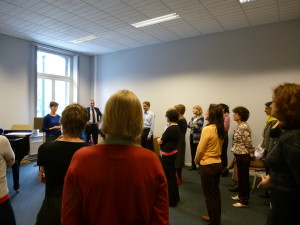Bojan Djordjev attended LFEO for RTD Chorale, a choir with people working for various European institutions. Bojan is an artist, currently making work in the context of Dasarts.

It’s a rainy morning, but Sablon is very charming even in this weather. Kristien is taking me to the place of today’s lecture. While talking about the piece and all different events that are taking place induced by this simple set-up, I admire Kristien’s newly acquired knowledge of the city after fixing all the appointments for Lecture for Every One. 40 meetings cover all spheres of life, layers and classes of society. We meet Sarah at the metro entrance. I ask her if she has a specific policy on me taking notes. I guess I am preparing myself for a lecture, still confused about the format. I have refrained from reading other eyewitnesses accounts of the lecture, I want to stay as blanco and as close to the «source» as possible. Then why take notes? Sarah agrees.
We arrive to the European quarter. The place we are going to is a building with thorough administrative security procedures. After filling out the forms with all our letters and numbers, we get guest stickers and are admitted. It’s empty. Our contact is very enthusiastic, she prepared herself and wants to give Sarah a proper introduction. Sarah checks out the room. It is pleasant and white with a very nice view on a patch of green grass – a park I guess – that is visible through the window. Rain makes it even greener. It is light and very acoustic, there is a baby grand piano, shiny black. The sound a conversation produces in this room makes the entire situation somehow – delightful! We sit in a side room, a kind of improvised salon/cloakroom, waiting for all the people to arrive. I ask Sarah details about the performance. I’m exercising my fantasy, letting it lose. We talk about remembering things. How I can remember random facts that are somehow systematised in my head as an autonomous hard drive. People are gathering in the corridor and soon we can hear a choir warm up. Cheerful noises of riffs, glissandos and melismas. These people who work for European institutions, come here on their lunch break to sing. It’s their precious hour of practice love for singing that will be chipped off today with a different kind of love.
Our host gets us, we enter quickly. Everyone is standing. Our host introduces Sarah. For her, this performance is about communication between different people. The sentence does not sound neutral spoken in the capital of EU and in this context. Sarah stands next to the piano, like at liederabend, and starts the lecture. The people from the choir are also standing. They had their warm-up, they are ready to sing, but their conductor is replaced with a lecture. I am standing behind, in the last row. What were the people’s reactions? I heard laughter at certain places, also direct and intuitive answers to the questions posed by Sarah. But what performance took place at audiences’ faces? How do they “sing”? I realised that I was behind a big and important part of the performance. But then again, if I wanted to see it I had to deliver a lecture. Then what kind of a witness am I?
What kind of performers’ skills one develops in order to be able to deliver a text and at the same time observe what is the text inducing and producing in faces and behaviour of people, because one is so close to one’s listeners. It is really a situation where you send the message into the air and see it reflected, and really the only thing one should care about is the effect the speech produces. But, that’s what we do all the time in life, no? This simple everyday reality of a conversation comes as something unusual in the frame of art piece.
And what kind of “neutralising” practice must Sarah have as a performer that is exposed in such a way? How to digest all the faces, all the reactions, radiation that is reflected back from the lecture? It’s a new kind of exhaustion.
I must say, I wasn’t thinking of all this during lecture. I was one of the every one. I also performed. I was listening to the lecture. It led me slowly to the point of my personal explosion. It happened somewhere in the middle of the lecture, so I could vaguely follow the rest. I reconstruct it in my head. I will probably reconstruct it in conversations I will have about the lecture. I am excited in working on its performance virally.
Where did the performance take place? Who are its audience? What kind of public space it creates? With this simple gesture, the fragmented, powerless public sphere of today is literally manually sewn back together by Sarah with each lecture. It’s for EVERY ONE, but really an attempt of WE. This WE we were robbed of. Maybe some new WE. It’s a brave artistic gesture, at the same time ambitious and humble.
We leave immediately after the end of the lecture. While trying to find a way out through confusing doors and corridors, we can hear the choir singing some African sounding song.
18. 05. 2013, two days after the visit.
Bojan Djordjev